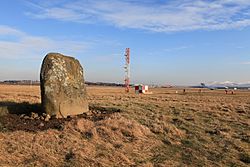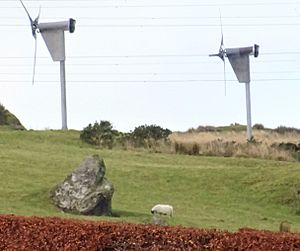Cat Stones of Scotland facts for kids
The Cat Stones of Scotland are special rocks or standing stones found across Scotland. Their name comes from the Gaelic word cath, which means battle. So, these stones are often linked to old battles or burial places. You might see their name spelled in different ways, like Catstone, Cat Stone, Catstane, or Cat's Stone.
Contents
What are Cat Stones?
Cat Stones are mostly connected to ancient battles or burial sites. Sometimes, they might also be linked to Scottish wildcats. Many hills in Scotland also have 'Cat' in their name, like Cat Law or Cat Hill. This 'Cat' part often means either 'summit' (the top of a hill) or 'battle'. Old piles of stones, called cairns, were sometimes called 'cat-heaps'. Cairns are often found at battlefields or burial spots. For example, a cairn at Knock in Renfrewshire was once thought to be where a famous leader named Somerled was killed.
Famous Cat Stone Locations
The Catstane near Edinburgh Airport

The Catstane is a large, single stone (a monolith) that was once the center of an old cemetery. This cemetery had long-cist burials, which are graves made with long stone boxes. The stone itself had an inscription from the 5th or 6th century AD. It said, "In this tomb lies Vetta, daughter of Victricus."
The Catstane is a rounded boulder, about 1.3 meters tall. It was part of a Bronze Age site from thousands of years ago. Later, people reused the stone for the Christian inscription. The Catstane used to stand near Edinburgh Airport. It was moved because of new building work.
People traditionally believed the Catstane marked a battle between Malcolm II and a leader named Constantine. Some even thought the name 'Catstane' came from 'Constantine'. The battle was supposedly fought about 2 miles west of the stone.
The Cat Stone in Perth and Kinross
This standing stone is one of a pair located near Fortingall. It is also known by its Gaelic names, Coille Dhubh or Clach Taghairm nan Cat. There's a legend that on Halloween, Scottish wildcats would gather around this stone. They would form a circle to honor a huge black cat sitting on top of the stone. Another stone, called the Stone of the Demon, stands nearby.
The Cat Craig in North Ayrshire
The Cat Craig is a rock feature found in the Barony of Ladyland. It is located next to the path leading to Cockston Farm. It is one of two rock formations enclosed by drystone walls.
The Cat Stane in North Ayrshire
On the lands of Blackstone, near Giffordland in North Ayrshire, you can find another important rock feature called the Cat Stane. We don't have many old stories about this specific stone. However, an old expert named John Smith thought it was a battle site.
This stone is easy to spot and stands out in the landscape. Because of this, it would have been a great meeting point for soldiers before a battle. Other places like the borestone at Giffen Castle and Greenhills near Beith were also used as rallying points. The famous Battle of Largs was fought in 1263, and a nearby place called Camphill is said to have been a gathering spot for the Scottish army.
The Cat Stone or Clach a'Chath on the Isle of Arran
The story connected to this Cat Stone says that around 1652, a small fight happened. It was between soldiers from Brodick Castle and local people at a place called Allt-a-Chlaideimh (Sword Burn). The last soldier was supposedly killed at Clach-a-Chath, which means the Battle Stone.
The Cat's Stone in Dumfries and Galloway
This stone is located in Dumfries and Galloway. It overlooks the original spot where Loch Doon Castle once stood.
The Cat Stone in Banff
At the top of Cat Stone Hill in Banff, there is a "large rock that is worn smooth by water." There are no historical stories or traditions linked to this particular stone.




